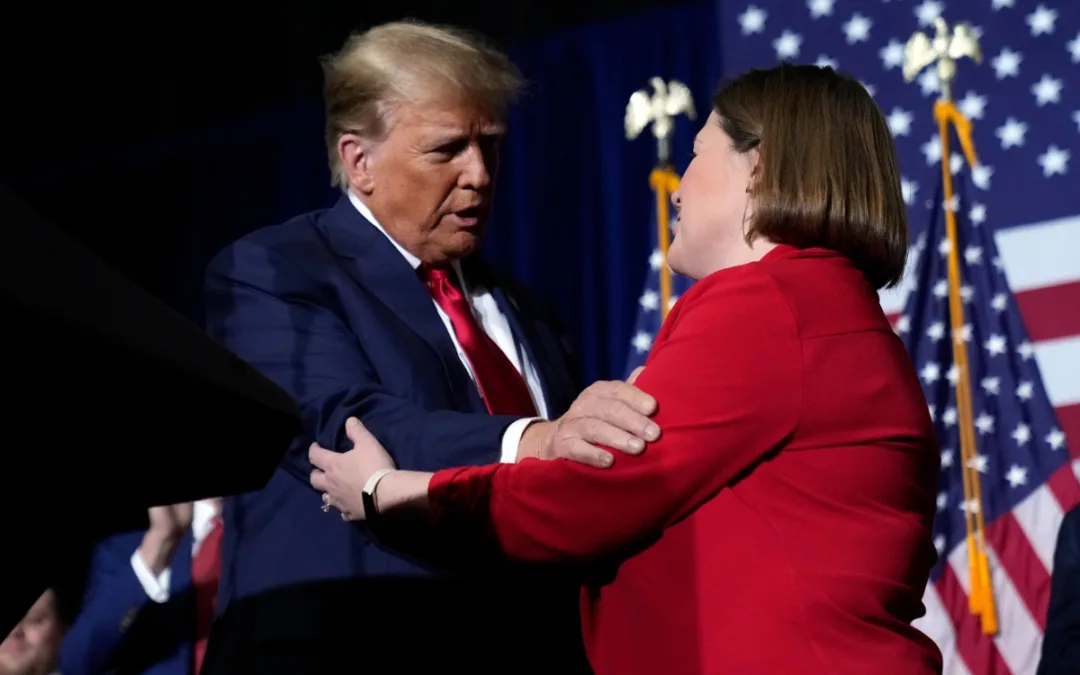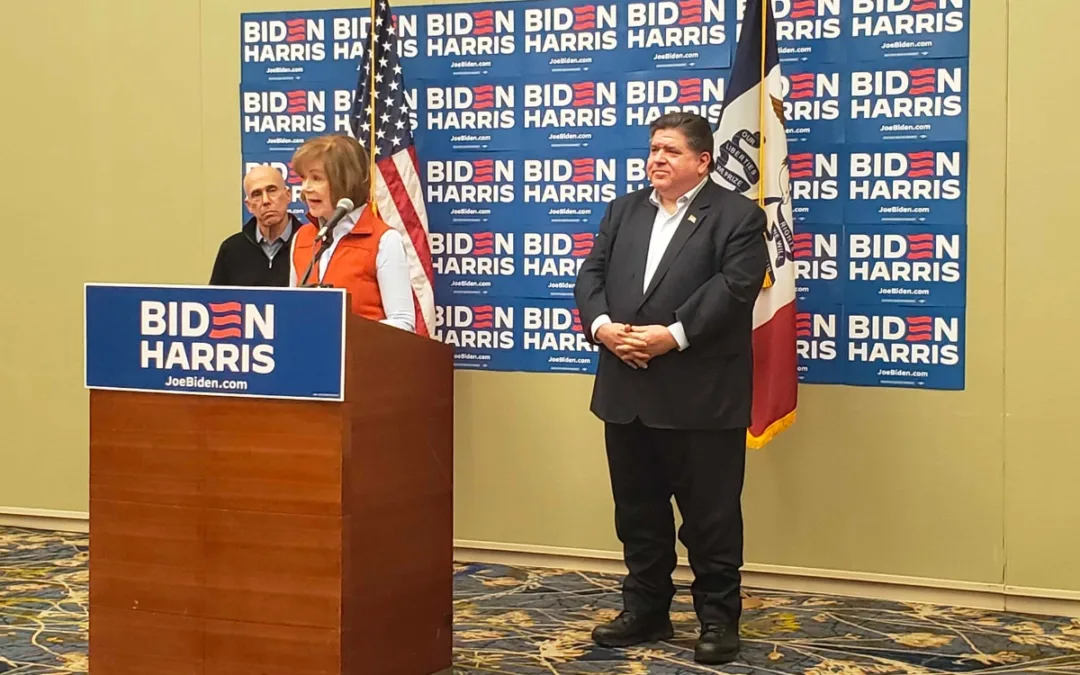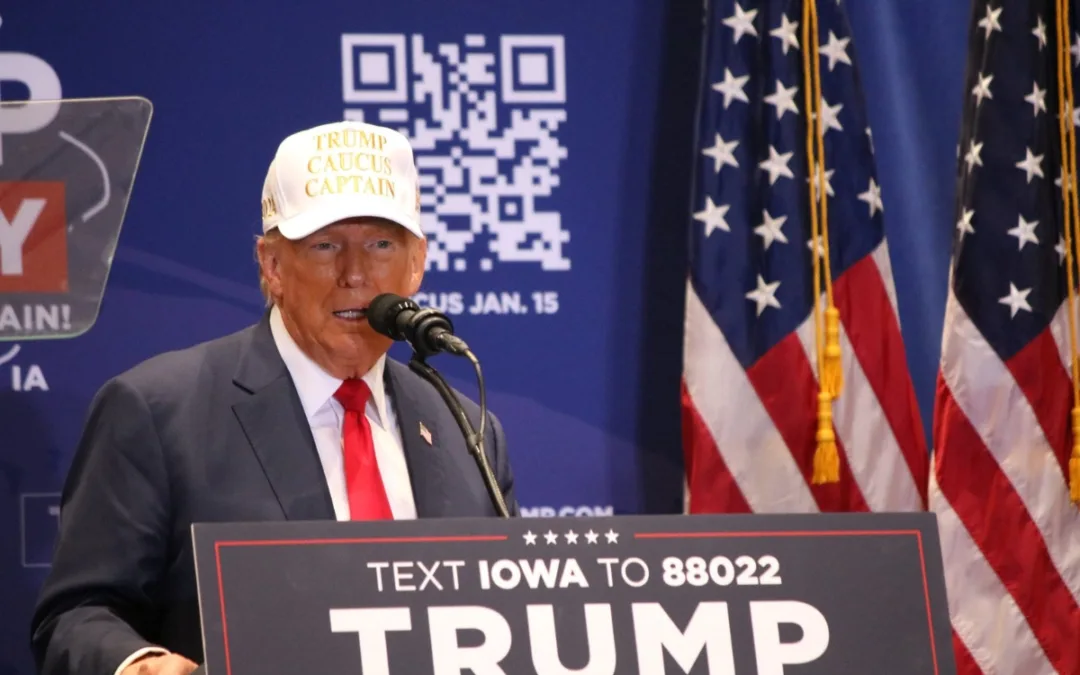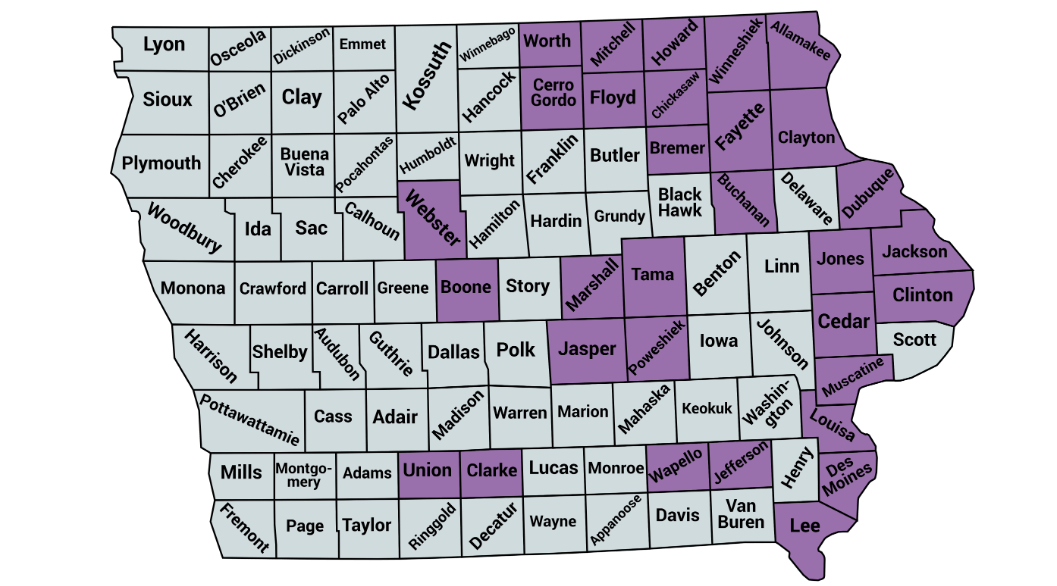
Counties that voted twice for Obama before backing Trump in 2016.
Kurt Meyer, chair of the Tri-County Democrats in north-central Iowa, spent Election Day 2016 knocking on doors in Cresco, about 50 miles from his home.
He was shoveling down a quick lunch with a fellow door-knocker when he first realized something might be off. The man Meyer was sharing a meal with said he was a member of the United Auto Workers.
He told Meyer he thought five out of six of his union brothers and sisters would be voting to elect Donald J. Trump as the next president of the United States.
“He said, ‘I’m running into real trouble,'” Meyer said. “And I was flabbergasted … On Election Day, you’re not trying to persuade anyone to your side. You’re just trying to turn people out. I’m certain in my intrepid door knocking, he and I were knocking on doors for people who were going to show up for Donald Trump.”
“You can sugarcoat that in a lot of different ways,” he said, “but the profound hope I have is we will be able to have those people meander back into our column this November.”
By the numbers, Meyers’ door knocking wasn’t all that fruitful. In 2016, 272 fewer people showed up to vote for a presidential candidate from one of the two major parties in Howard County than in 2012. Voter turnout was actually lower in 2016 than it was in 2012 in all 31 Iowa counties Trump flipped after they voted for Barack Obama twice.
But Howard County’s results were rather noteworthy for a different reason: it was the county that famously saw the largest swing in the country from Obama to Trump. In 2012, Obama carried it by 21 points; Trump won it by 20 in 2016.
[inline-ad id=”4″]
In all, Iowa has 31 counties that voted twice for Obama before for going for Trump, the most of any state in the nation. That’s made for an attractive campaign target for the Democratic presidential candidates here over the past year.
On nearly every trip a candidate makes in Iowa, their campaign is sure to point out how many Obama-to-Trump counties they’re visiting. With a Democratic base concerned about electability, the message is simple from the White House hopefuls: they’re the one who can win those Iowa pivot counties back.
But once the Iowa Caucus is complete next month, it’ll be up to local Democratic activists to swing those counties back to blue. And they all have ideas on just what went wrong in 2016, how the Democrats’ caucus campaigning has helped their efforts and what the top-of-ticket needs to do in 2020.
Starting Line interviewed many of the local Democratic Party county chairs from Obama-to-Trump counties this past week.
Howard County (Cresco)
Obama 59.8%, 2,767 votes Romney 38.8%, 1,793 votes Total Votes 4,560
Trump 57.3%, 2,611 votes Clinton 36.8%, 1,677 votes Total Votes 4,288
Mitchell County
Obama 50.7%, 2,831 votes Romney 47.4%, 2,643 votes Total Votes 5,474
Trump 58.9%, 3,190 votes Clinton 34.9%, 1,888 votes Total Votes 5,078
Worth County
Obama 56.6%, 2,343 votes Romney 42.1%, 1,743 votes Total Votes 4,086
Trump 57.6%, 2,453 votes Clinton 35.9%, 1,530 votes Total Votes 3,983
[inline-ad id=”5″]
2016: What Went Wrong?
Almost all of the county chairs Starting Line interviewed talked about, or alluded to, Sen. Bernie Sanders’ prior presidential run when asked what happened when Trump flipped their counties in 2016.
Some of the county chairs were Sanders supporters in 2016 and are still backing the candidate.
“We had a lot of people who were very unhappy with the way everything panned out in ’16. A lot of Bernie people thought that, you know, the election was stolen from him,” Julie Geopfert, chair of the Webster County Democrats, said. “I don’t think those people, the activists, were the ones responsible for the county flipping red. I really think they came back and did what they knew they had to do, whether they liked it or not. But I think we had a lot of inactive, registered Democrats who stayed home. There was a good portion of them who were in the no-Hillary camp and they either voted for Trump or they didn’t vote.”
Bill Jacobs, a Sanders supporter in 2016 and chair of the Clinton County Democrats, was off to meet the Sanders campaign the day Starting Line reached out to him earlier this week.
“I want to make sure he and his supporters are working with the party rather than trying to work against the party, and just to make sure they feel they are a part of the party,” Jacobs said. “That was the biggest schism I saw in 2016.
“The sad part is, I was a Bernie supporter in 2016,” Jacobs said. “It was disheartening to see other Bernie supports remain unenthusiastic and work not as hard to keep pulling everyone in the same direction.”
[inline-ad id=”0″]
Webster County
Obama 52.2%, 9,458 votes Romney 46.7%, 8,453 votes Total Votes 17,911
Trump 57.7%, 10,056 votes Clinton 36.2%, 6,305 votes Total Votes 16,361
Clinton County
Obama 60.8%, 15,123 votes Romney 37.9%, 9.423 votes Total Votes 24,546
Trump 48.9%, 11,276 votes Clinton 43.3%, 10,095 votes Total Votes 21,371
Meanwhile, down in Ottumwa, Zach Simonson said the low voter turnout was the culmination of a gradual decline of Democrats in the area. The town has lost several manufacturing plants.
“Ottumwa was a real strong union town,” Simonson, the Wapello County Democrats chair, said. “Now we have a growing immigrant community and there’s a wide backlash to those folks that Trump did a good job capitalizing on.”
“I don’t know if you’re going to win those people back,” Simonson said. “You don’t convince people they should repudiate those kind of nasty things in just a few years.”
[inline-ad id=”1″]
And in Winneshiek County, chairman Nathan Thompson said generating enthusiasm within the party seemed to be particularly difficult in 2016.
More than 700 third-party ballots were cast there. But, Thompson said, the party has slowly been rebuilding. They’ve almost caught up to Republicans in terms of voter registration.
There are still more than 5,000 voters who identify as “No Party” in Winneshiek County, but registered Republicans only narrowly lead registered Democrats there now.
“We’re probably 150 people behind the Republicans at this point,” Thompson said. “With the caucuses, we’re hoping to overtake that.”
Winneshiek County
Obama 56.7%, 6,246 votes Romney 41.9% 4,618 votes Total Votes 10,864
Trump 47%, 5,344 votes Clinton 46.2% 5,354 votes Total Votes 10,689
Wapello County
Obama 55.1%, 8,616 votes Romney 43.4%, 6,777 votes Total Votes 15,393
Trump 57.5%, 8,715 votes Clinton 36.9%, 5,594 votes Total Votes 14,309
[inline-ad id=”2″]
2020: Turning The Tide
Tiffany Gale, chair of the Union County Democrats, is trying to gain momentum in her county with good old grassroots organizing.
“We are really trying to do different events to get people more involved with our party,” Gale said. “To start, we want to get them excited about the caucuses coming up.”
She’s hosting social hours and fun, family-friendly events in an attempt to attract younger voters.
It’s a worthwhile goal in Union County, where around 44% of the population is between the ages of 18 and 44, according to 2017 U.S. Census data.
Gale has also hosted a number of debate watch parties so voters in her county can get to know the presidential candidates. After the caucus, she’s ready to turn her volunteers’ focus to taking back Sen. Joni Ernst’s seat. It’s one of the most vulnerable in the nation.
Several of the 31 counties Trump flipped are in Congressman Steve King’s district. Democrats there are prepared for a battle as well.
JoAnn Hardy, in Cerro Gordo County, said King’s Democratic competitor, J.D. Scholten, has garnered a lot of enthusiasm around Mason City.
“We just love him here,” Hardy said. “It was a really close race for him last time.”
[inline-ad id=”3″]
Those aren’t the only races that could have an impact on turnout that benefits Democrats up and down the ballot, though.
Meyer said the Mitchell County Board of Supervisors will go from a three-member board to a five-member board.
“That means we will have some competitive local races where there is no incumbent,” Meyer said. “Every supervisor candidate will probably bring 25 new people to the polls that probably otherwise wouldn’t have voted.”
Union County
Obama 51.3%, 3,029 votes Romney 47.5%, 2,800 votes Total Votes 5,829
Trump 60.4%, 3,525 votes Clinton 33%, 1,922 votes Total Votes 5,477
Cerro Gordo
Obama 56.1%, 13,204 votes Romney 42.8%, 10,084 votes Total Votes 23,288
Trump 50.6%, 11,621 votes Clinton 42.9%, 9,862 votes Total Votes 21,483
Grady pointed out there’s a competitive race afoot in Marshall County. Dave Degner will run against Republican Sen. Jeff Edler in Iowa Senate District 36.
Simonson said the big race in Wapello County will be trying to retain Mary Gaskill’s District 81 seat in the Iowa House.
“It’s going to be a lot less exciting now that we know she is seeking reelection,” Simonson said. “But we’d be a lot more nervous if we had to put out a new candidate who didn’t have her experience.”
[signup_form]
“We pay attention to people who win the new races, but we have to play defense, too,” he said. “Defending that seat is going to be hard, but on the down-ballot we’ve done great with Democrats.”
Clinton County is home to Rita Hart, who is running for Democrat Dave Loebsack’s 2nd Congressional District seat. Loebsack is retiring at the end of his term. The Clinton County Democrats are reaching even further down the ballot than that to drive the vote.
“The races that are usually nonpartisan, the soil and water boards … We’re trying to recruit Democrats there because there are so many currently held by Republicans, and men too,” Jacobs said. “We think it’s time for the Democratic Party to get involved. We’ve had a big swing on our city council recently.”
Marshall County
Obama 53.9%, 10,085 votes Romney 44.9%, 8,411 votes Total Votes 18,496
Trump 50.9%, 9,146 votes Clinton 42.6%, 7,652 votes Total Votes 16,798
[inline-ad id=”6″]
Trump May Be His Own Biggest Enemy
In general, Thompson, of Winneshiek County, said 2020 could be tricky.
“The economy is decent and there’s low unemployment, and things appear to be superficially very well here,” he said.
But, Trump may just shoot himself in the foot.
“I do think people are getting really motivated and they’re really starting to pay attention to what’s happening in Iran,” Thompson said. “It seems like people are very alarmed about what’s going on. It could be a real help to motivate people.”
Jacobs said he’s seen yard signs starting to pop up that say, “Any Functioning Adult 2020.”
“That’s certainly the sentiment out there,” he said. “I think that’s the primary motivating factor for a lot of people, to make sure we get Trump out of office.”
Simonson said he hasn’t found the formula for guiding people back to the party yet, but said, “People are definitely more and more exhausted with Trump.”
“There were a lot of people who voted for him who weren’t gung-ho about it,” Simonson said. “They are at least open to voting for other people now, and [Trump] alienates a few more of those every day.”
[inline-ad id=”7″]
The dislike of Trump has been a motivating factor for many Iowa Democrats since 2016.
“As soon as he was elected, we saw an increase of a huge number of people who showed up at our events and meetings,” Hardy said. “There are more people involved in politics. We found out we can’t sit back and just expect things to be OK, so I expect a lot better participation in this election cycle.”
Under President Barack Obama, she said, people just sort of trusted that things were going to be fine.
“Now, you have to be on guard all of the time because another terrible thing is just around the corner,” Hardy said.
Meyer also believes one of the hinge issues in 2020 is going to be competence.
“I think there is a prevailing sense among those who are tracking such matters that Trump is in over his head and he really doesn’t know what he’s doing,” Meyer said.
People are looking for a candidate who strikes people as being reasonable, smart and who is able to figure things out beyond the fourth-grade level, he said.
“I also think, increasingly, that the Trump Administration took on a lot of people who are just being a bunch of rogue players that don’t share an interest in the welfare of this country, but are rather in it for a more perverted, narrow, selfish interest,” Meyer said. “I think that’s likely to be an issue.”
[inline-ad id=”8″]
Large Presidential Field Brings Democrats Together
Sen. Elizabeth Warren’s Iowa team often boasts about its strong ground game in Iowa, and for good reason.
“I think she’s doing a really good job with that. Her campaign is connecting with people all over the county,” Thompson said. “They’re knocking on rural doors that are really hard to get to. They’re basically just being present.”
While part of Warren’s strategy is sending more field organizers out, having a large Democratic field is drawing diverse groups of people in for town halls and meetings more often than ever.
According to the Des Moines Register’s Iowa Caucuses Candidate Tracker, the 10 candidates who hosted the most events in Iowa this election cycle have made it to 1,209 events so far.
Meyer said all of those events are having an impact.
“When candidates host events in homes or in a restaurant in our county seat, there are 35, 40, 45 or 50 people, so they’re usually manageable and you can engage with people,” Meyer said. “A candidate may only be there for 60 minutes, but you will be there 90 minutes and you get to know people of a vaguely similar mindset. Friendships develop.”
Once people make those connections, he said, they’re more likely to come to central committee meetings later on.
As for whether the party will be able to reunited after the primaries are over, Meyer is hopeful.
“We’ll probably have eight candidates viable at Mitchell County precincts, maybe nine,” Meyer said. “That’s a broad spectrum, yet that’s probably a good thing. Whomever commandeers the nomination will help contribute to the tide that will lift all boats.”
[inline-ad id=”9″]
“Who we elect in November has a dramatic effect on the life of us all, but you can’t have such a furrowed brow about it that it makes you embittered if the candidate you support [in the primary] doesn’t come out on top,” Meyer said. “You win some, you lose some.”
No matter who is victorious in the primaries, the county chairs are ready to work as hard as they can to flip the counties back to blue.
“All I know is we’ve got to work it this time and we’ve got to work it hard,” Geopfert said. “We can’t let things go back to the way they have been.”
By Paige Godden
Posted 1/12/2020
Politics
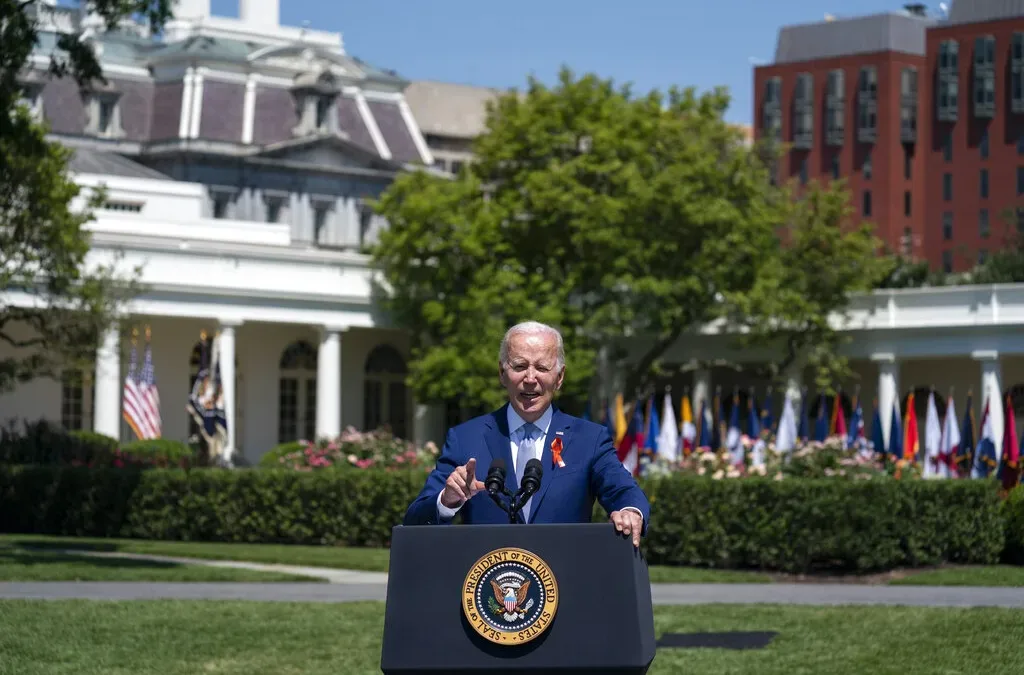
Biden announces new action to address gun sale loopholes
The Biden administration on Thursday announced new action to crack down on the sale of firearms without background checks and prevent the illegal...

Biden cancels student loan debt for 2,690 more Iowans
The Biden administration on Friday announced its cancellation of an additional $7.4 billion in student debt for 277,000 borrowers, including 2,690...
Local News

No more Kum & Go? New owner Maverik of Utah retiring famous brand
Will Kum & Go have come and gone by next year? One new report claims that's the plan by the store's new owners. The Iowa-based convenience store...

Here’s a recap of the biggest headlines Iowa celebs made In 2023
For these famous Iowans, 2023 was a year of controversy, career highlights, and full-circle moments. Here’s how 2023 went for the following Iowans:...


